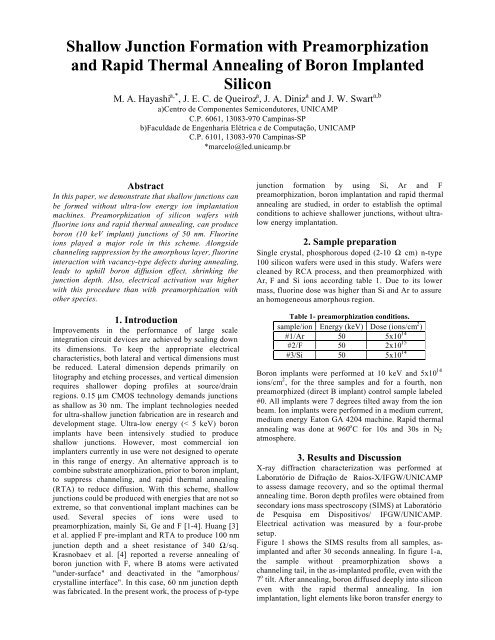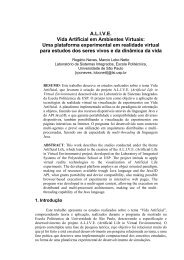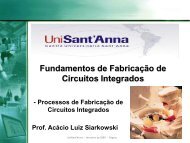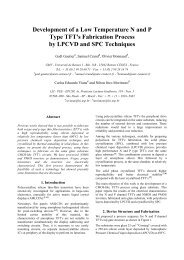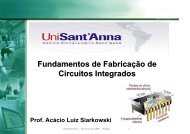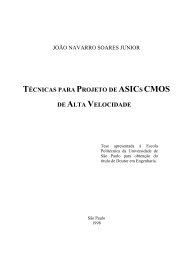Shallow Junction Formation with Preamorphization and Rapid ... - LSI
Shallow Junction Formation with Preamorphization and Rapid ... - LSI
Shallow Junction Formation with Preamorphization and Rapid ... - LSI
You also want an ePaper? Increase the reach of your titles
YUMPU automatically turns print PDFs into web optimized ePapers that Google loves.
<strong>Shallow</strong> <strong>Junction</strong> <strong>Formation</strong> <strong>with</strong> <strong>Preamorphization</strong><br />
<strong>and</strong> <strong>Rapid</strong> Thermal Annealing of Boron Implanted<br />
Silicon<br />
M. A. Hayashi a,* , J. E. C. de Queiroz a , J. A. Diniz a <strong>and</strong> J. W. Swart a,b<br />
a)Centro de Componentes Semicondutores, UNICAMP<br />
C.P. 6061, 13083-970 Campinas-SP<br />
b)Faculdade de Engenharia Elétrica e de Computação, UNICAMP<br />
C.P. 6101, 13083-970 Campinas-SP<br />
*marcelo@led.unicamp.br<br />
Abstract<br />
In this paper, we demonstrate that shallow junctions can<br />
be formed <strong>with</strong>out ultra-low energy ion implantation<br />
machines. <strong>Preamorphization</strong> of silicon wafers <strong>with</strong><br />
fluorine ions <strong>and</strong> rapid thermal annealing, can produce<br />
boron (10 keV implant) junctions of 50 nm. Fluorine<br />
ions played a major role in this scheme. Alongside<br />
channeling suppression by the amorphous layer, fluorine<br />
interaction <strong>with</strong> vacancy-type defects during annealing,<br />
leads to uphill boron diffusion effect, shrinking the<br />
junction depth. Also, electrical activation was higher<br />
<strong>with</strong> this procedure than <strong>with</strong> preamorphization <strong>with</strong><br />
other species.<br />
1. Introduction<br />
Improvements in the performance of large scale<br />
integration circuit devices are achieved by scaling down<br />
its dimensions. To keep the appropriate electrical<br />
characteristics, both lateral <strong>and</strong> vertical dimensions must<br />
be reduced. Lateral dimension depends primarily on<br />
litography <strong>and</strong> etching processes, <strong>and</strong> vertical dimension<br />
requires shallower doping profiles at source/drain<br />
regions. 0.15 µm CMOS technology dem<strong>and</strong>s junctions<br />
as shallow as 30 nm. The implant technologies needed<br />
for ultra-shallow junction fabrication are in research <strong>and</strong><br />
development stage. Ultra-low energy (< 5 keV) boron<br />
implants have been intensively studied to produce<br />
shallow junctions. However, most commercial ion<br />
implanters currently in use were not designed to operate<br />
in this range of energy. An alternative approach is to<br />
combine substrate amorphization, prior to boron implant,<br />
to suppress channeling, <strong>and</strong> rapid thermal annealing<br />
(RTA) to reduce diffusion. With this scheme, shallow<br />
junctions could be produced <strong>with</strong> energies that are not so<br />
extreme, so that conventional implant machines can be<br />
used. Several species of ions were used to<br />
preamorphization, mainly Si, Ge <strong>and</strong> F [1-4]. Huang [3]<br />
et al. applied F pre-implant <strong>and</strong> RTA to produce 100 nm<br />
junction depth <strong>and</strong> a sheet resistance of 340 Ω/sq.<br />
Krasnobaev et al. [4] reported a reverse annealing of<br />
boron junction <strong>with</strong> F, where B atoms were activated<br />
"under-surface" <strong>and</strong> deactivated in the "amorphous/<br />
crystalline interface". In this case, 60 nm junction depth<br />
was fabricated. In the present work, the process of p-type<br />
junction formation by using Si, Ar <strong>and</strong> F<br />
preamorphization, boron implantation <strong>and</strong> rapid thermal<br />
annealing are studied, in order to establish the optimal<br />
conditions to achieve shallower junctions, <strong>with</strong>out ultralow<br />
energy implantation.<br />
2. Sample preparation<br />
Single crystal, phosphorous doped (2-10 Ω cm) n-type<br />
100 silicon wafers were used in this study. Wafers were<br />
cleaned by RCA process, <strong>and</strong> then preamorphized <strong>with</strong><br />
Ar, F <strong>and</strong> Si ions according table 1. Due to its lower<br />
mass, fluorine dose was higher than Si <strong>and</strong> Ar to assure<br />
an homogeneous amorphous region.<br />
Table 1- preamorphization conditions.<br />
sample/ion Energy (keV) Dose (ions/cm 2 )<br />
#1/Ar 50 5x10 14<br />
#2/F 50 2x10 15<br />
#3/Si 50 5x10 14<br />
Boron implants were performed at 10 keV <strong>and</strong> 5x10 14<br />
ions/cm 2 , for the three samples <strong>and</strong> for a fourth, non<br />
preamorphized (direct B implant) control sample labeled<br />
#0. All implants were 7 degrees tilted away from the ion<br />
beam. Ion implants were performed in a medium current,<br />
medium energy Eaton GA 4204 machine. <strong>Rapid</strong> thermal<br />
annealing was done at 960 o C for 10s <strong>and</strong> 30s in N 2<br />
atmosphere.<br />
3. Results <strong>and</strong> Discussion<br />
X-ray diffraction characterization was performed at<br />
Laboratório de Difração de Raios-X/IFGW/UNICAMP<br />
to assess damage recovery, <strong>and</strong> so the optimal thermal<br />
annealing time. Boron depth profiles were obtained from<br />
secondary ions mass spectroscopy (SIMS) at Laboratório<br />
de Pesquisa em Dispositivos/ IFGW/UNICAMP.<br />
Electrical activation was measured by a four-probe<br />
setup.<br />
Figure 1 shows the SIMS results from all samples, asimplanted<br />
<strong>and</strong> after 30 seconds annealing. In figure 1-a,<br />
the sample <strong>with</strong>out preamorphization shows a<br />
channeling tail, in the as-implanted profile, even <strong>with</strong> the<br />
7 o tilt. After annealing, boron diffused deeply into silicon<br />
even <strong>with</strong> the rapid thermal annealing. In ion<br />
implantation, light elements like boron transfer energy to
the target mainly by electron collisions, causing less<br />
damage to the crystalline lattice. In this process, point<br />
defect clusters are generated along the collision cascade.<br />
Thermal annealing dissolute these clusters, producing a<br />
supersaturation of self-interstitials. The excess<br />
interstitials kick dopants out of substitutional locations to<br />
form mobile dopant-interstitial complexes that broaden<br />
the doping profile, the so-called transient enhanced<br />
diffusion. So, rapid thermal annealing alone, couldn’t<br />
avoid boron diffusion.<br />
Boron concentration(cm -3 )<br />
10 20 a<br />
10 19<br />
10 18<br />
10 17<br />
10 16<br />
as-implanted<br />
RTP 960 o C/30s<br />
10 15<br />
0 50 100 150 200 250 300 350<br />
10 20<br />
10 19<br />
b<br />
#1<br />
10 18<br />
10 17<br />
10 16<br />
10 15<br />
0 50 100 150 200 250 300 350<br />
10 20<br />
10 19<br />
c<br />
10 18<br />
#2<br />
10 17<br />
10 16<br />
10 15<br />
0 50 100 150 200 250 300 350<br />
10 20 d<br />
10 19<br />
#3<br />
10 18<br />
10 17<br />
10 16<br />
10 15<br />
0 50 100 150 200 250 300 350<br />
depth(nm)<br />
#0<br />
Fig. 1: SIMS profiles of B, as-implanted <strong>and</strong> after<br />
rapid thermal annealing 960 o C/30s. a)no<br />
preamorphization, b)preamorphization <strong>with</strong> argon,<br />
c)preamorphization <strong>with</strong> Si, d)preamorphization<br />
<strong>with</strong> F. All boron implants were done at 10 keV.<br />
Figure 1-b shows the profiles for Ar preamorphized<br />
sample. Compared to fig. 1-a, as-implanted profile<br />
shows that preamorphization reduced the channeling<br />
effect, but after annealing, diffusion shows up, <strong>and</strong> the<br />
previous advantage was lost. Previous work <strong>with</strong><br />
gettering mechanisms [5] showed that high dose Ar<br />
implants produce Si-interstitials that enhances boron<br />
diffusion. Fig. 1-c shows that preamorphization <strong>with</strong> Si<br />
was slightly less effective to avoid channeling than Ar,<br />
due to its lower mass, but the annealed profile shows that<br />
diffusion was supressed <strong>with</strong> rapid thermal annealing.<br />
Fluorine preamorphization (fig. 1-d) had a more<br />
noticeable effect. In addition to channeling supression in<br />
the as-implanted profile, the annealed sampled produced<br />
a very shallow (50 nm) boron profile, smaller than the<br />
as-implanted one. The expected result was a depth<br />
profile at least the same as before annealing, as we<br />
observed in Si preamorphization. Boron diffusion<br />
suppression was explained [3] by the interaction of<br />
excess F ions <strong>with</strong> interstitial Si, that otherwise are<br />
responsible for the enhanced diffusion. Probably, the<br />
formation of thermodynamically stable SiF x complexes,<br />
would immobilize this interstitials. However, we don't<br />
have a conclusive answer to the boron profile shrinkage.<br />
It is thought that a high vacancy-type defects<br />
concentration at the under-surface would be responsible<br />
for this effect, capturing boron ions. One experimental<br />
evidence [6] of a vacancy-rich region is that F <strong>and</strong> Cl<br />
ions implanted in Si, increase the oxidation rate <strong>and</strong><br />
suppress the formation of stacking fault defects,<br />
increasing vacancy-type defects. Although unexpected,<br />
junction shrinkage after thermal annealing already was<br />
observed in Mg-implanted GaAs [7]. This “uphill<br />
diffusion”, was explained by the substitutionalinterstitial<br />
diffusion mechanism. In the region of uphill<br />
diffusion, the dopants diffuse from areas of excess<br />
interstitials toward areas of excess vacancies. So, this<br />
model could be a reasonable explanation of the observed<br />
junction shrinkage.<br />
Table 2: Measured sheet resistance<br />
sample R S (Ω/sq)<br />
RTP 960 o C/10s<br />
R S (Ω/sq)<br />
RTP 960 o C/30s<br />
#0 (B) 589 335<br />
#1 (Ar+B) 426 335<br />
#2 (Si+B) 303 303<br />
#3 (F+B) 272 253<br />
Sheet resistance for all samples, table 2, were measured<br />
in a four-probe setup. 10 seconds treatment was not<br />
enough to complete activation on sample #0(direct B<br />
implant), but as shown before, increasing the time causes<br />
excess diffusion. The same occurs <strong>with</strong> the argon<br />
implanted sample #1. Sample #2, <strong>with</strong> Si pre-implant,<br />
had the same sheet resistance for both treatments,<br />
indicating that it needs less time to get higher electrical<br />
activation. This result is in agreement <strong>with</strong> X-ray<br />
diffraction measurements that showed a complete<br />
recrystallization after 10 seconds annealing.<br />
Unfortunately, due to a lack of time, we don’t have the
junction depth profile for the 10 second annealed<br />
samples. Sample #3, <strong>with</strong> fluorine, had the best<br />
activation value after 30 seconds annealing, <strong>and</strong> from X-<br />
ray diffraction, it only had total damage recovery after<br />
that treatment time. The measured electrical activation<br />
value of 253 Ω/sq for this sample is very close to the<br />
theoretical estimated value of 250 Ω/sq. This theoretical<br />
value was calculated assuming complete boron<br />
activation, <strong>with</strong> equation 1:<br />
1<br />
R S<br />
=<br />
µqΦ<br />
(1)<br />
where the mobility µ was assumed 50 cm 2 /V.s for a<br />
dopant concentration of 10 20 cm -3 (from SIMS<br />
measurements), q is the electron charge <strong>and</strong> Φ is the<br />
boron implantation dose, 5x10 14 cm -2 .<br />
The higher electrical activation of B near the surface is<br />
also in accordance to the above mentioned model of subsurface<br />
vacancy-rich region formation due to the deeper<br />
Si-interstitial-F complex formation.<br />
4. Conclusion<br />
From the results obtained so far, we can conclude that<br />
low energy boron implantation, <strong>with</strong>out previous<br />
amorphization of the silicon substrate is not suitable for<br />
shallow junction fabrication, due to its severe channeling<br />
<strong>and</strong> diffusion effects. The preamorphization scheme,<br />
along reducing channeling, in Si <strong>and</strong> F cases suppressed<br />
the boron thermal diffusion. Fluorine has a remarkable<br />
effect, showing junction shrinkage after rapid thermal<br />
annealing, <strong>and</strong> the best values of electrical activation.<br />
Although some authors previously reported shallow<br />
junctions obtained from fluorine pre-implants, as far as<br />
we know, it is the first time that a uphill diffusion<br />
mechanism was observed in boron implanted silicon.<br />
Also, it was demonstrated that available commercial ion<br />
implantation machines are still useful to shallow<br />
junctions production.<br />
The authors thank J. Godoy Filho <strong>and</strong> R. M. A. G.<br />
Floriano for technical support, <strong>and</strong> M. A. A. Pudenzi for<br />
SIMS measurements. We also thank FAPESP for<br />
financial support.<br />
References<br />
[1] S. Saito, K. Kumagai <strong>and</strong> T. Kondo, Appl. Phys. Lett. 63<br />
(2), pp.197-199, jul. 1993.<br />
[2] S. Aronovitz, H. Puchner <strong>and</strong> J. Kimball, J. Appl. Phys. 85<br />
(7), pp.3494-3498, apr. 1999.<br />
[3]T. Huang, H. Kinoshita <strong>and</strong> D. L. Kwong, Appl. Phys. Lett.<br />
65 (14), pp. 1829-1831, oct. 1994.<br />
[4] L. Y. Krasnobaev, J. J. Cuomo <strong>and</strong> O. I. Vyletalina, J.<br />
Appl. Phys. 82 (10), pp. 5185-5190, nov. 1997.<br />
[5]G. B. Bonner <strong>and</strong> J. D. Plummer, Appl. Phys. Lett. 46 (5),<br />
pp. 510-513, mar. 1985.<br />
[6]G. Greeuw <strong>and</strong> J. F. Verwey, Solid-State Electron. 26, pp.<br />
241-246, 1983.<br />
[7]H. G. Robinson, M. D. Deal<strong>and</strong> D. A. Stevenson, Appl.<br />
Phys. Lett. 56 (6), pp.554-557, feb. 1990.


